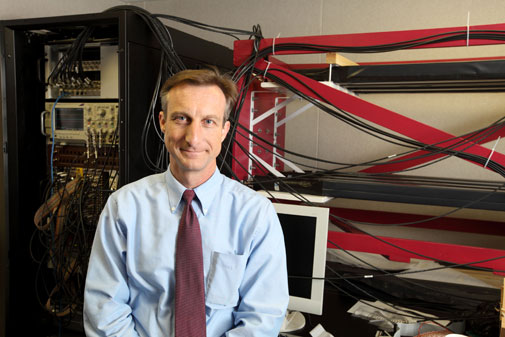Westmont Gets High-Tech Science Equipment
By
Westmont

The first shipment of high-tech particle-detector equipment, funded through a multi-institutional $1.2 million National Science Foundation MRI grant, has arrived at Westmont. The 16 large scintillation bar detectors will be used in the study of properties of neutron-rich rare isotopes which do not exist on Earth, but participate in important astrophysical reactions within supernova explosions and on the crust of neutron stars.
Westmont students will construct, test and calibrate the 16 detectors which will form one layer of a new Large-area multi-Institutional Scintillator Array (LISA). Eight other primarily undergraduate institutions will also each build a neutron detector layer for LISA, which will be housed at the National Superconducting Cyclotron Laboratory (NSCL) at Michigan State University, a facility that already hosts the Modular Neutron Array (MoNA), an instrument developed through a consortium that included Westmont. After Westmont students complete construction of the detector modules, each about 6-and-a-half feet long, 4 inches wide, they will be transported to MSU this summer and the students will assist in the assembly of the whole array onsite. The two large arrays together will form the MoNA-LISA detector.
Warren Rogers, Westmont physics professor, says the study of exotic nuclei is crucial to the understanding of how heavier elements are formed in explosive astrophysical environments. “This research will address questions about the origin of the elements in the universe,” Rogers says, “such as how certain elements heavier than iron are produced that are not explained by standard stellar nucleosynthesis processes.
“The quest for fundamental knowledge of our universe has always been deeply meaningful to humankind,” Rogers says. “And while basic research is not motivated by a desire to develop new technologies, it is common for unanticipated advances in technology to arise from basic research.”
In addition to Westmont, the LISA collaboration includes Central Michigan University, Concordia College, Gettysburg College, Hope College, Indiana University South Bend, Ohio Wesleyan, Rhodes College and Wabash College.
Westmont students also constructed the Westmont Cosmic Muon Detector Array (CMDA) consisting of 8 scintillation detectors, modeled after the MoNA array. After developing, testing and calibrating the array, they used it for research, tracking the flux of cosmic muons over the Santa Barbara sky. But the Tea Fire left the CMDA in ashes along with the rest of Rogers’ Westmont-based research. Since then he and his students have rebuilt a new CMDA array and are on the verge of taking data once again.
“I am very excited about the future of our research program at MSU,” Rogers says. “In addition to Westmont undergraduates having opportunity to participate in experiments at the NSCL using MoNA-LISA, they will soon be able to work at the next generation accelerator for the US currently under construction, the “Facility for Rare Isotope Beams” (FRIB), in which the MoNA-LISA array will be central to the study of neutron-rich exotic nuclei.”
Filed under
Campus News